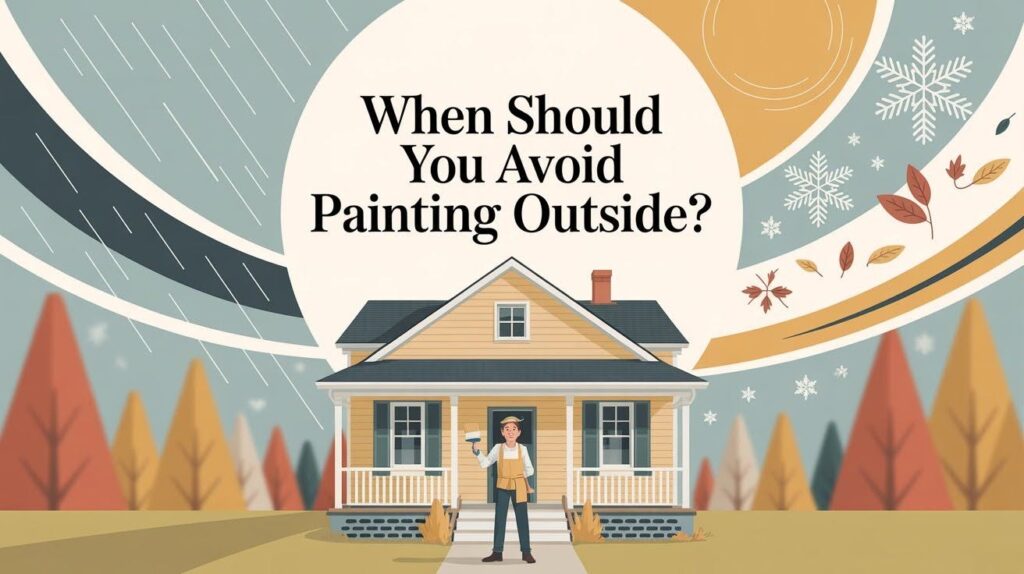After two decades of exterior painting projects, I’ve learned that Mother Nature calls the shots when it comes to outdoor paint jobs. Last spring, I watched a neighbor rush to finish his deck before a family gathering, ignoring the weather forecast.
Three weeks later, the paint was already cracking and peeling – a costly mistake that could have been avoided.
Weather conditions can make or break your exterior painting project. Paint applied in the wrong temperature, humidity, or wind conditions leads to poor adhesion, uneven coverage, and premature failure.
I’ve seen beautiful paint jobs turn into disasters simply because someone didn’t check the forecast first.
Understanding when to paint and when to wait, will save you time, money, and the frustration of redoing work that should have lasted years.
Weather Conditions That Make Painting a No-Go
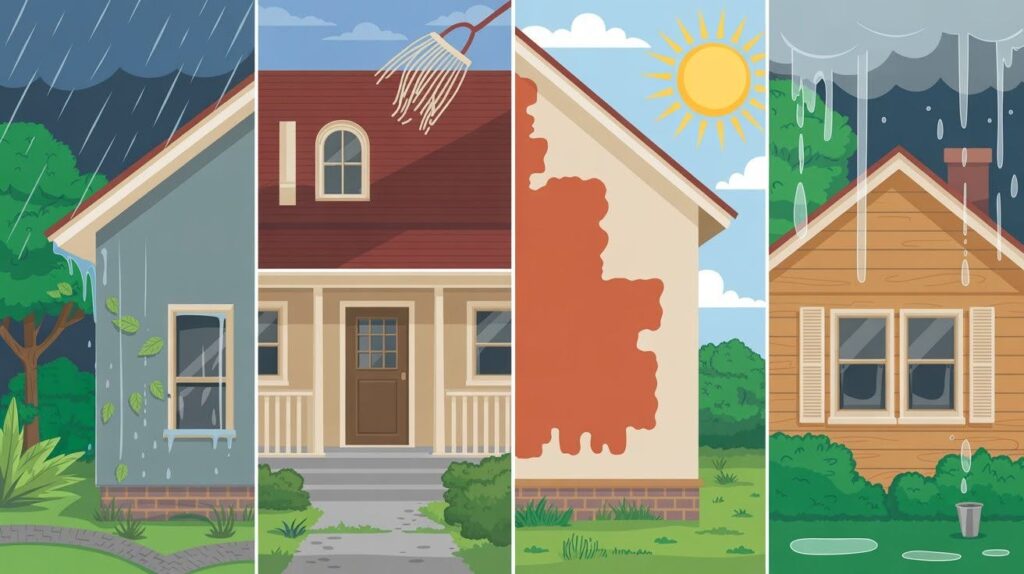
Rain and Moisture
Nothing destroys a paint job faster than unexpected rain. I’ve seen homeowners lose entire weekends of work when surprise showers hit just hours after finishing.
Even morning dew causes problems – high moisture prevents paint from curing properly, creating a soft, tacky surface that never fully hardens.
Windy Conditions
Wind blows debris onto wet paint and causes uneven drying, creating visible lap marks. I’ve watched perfectly good jobs get ruined by leaves stuck in fresh paint. Plus, there’s the safety issue of working with ladders in gusty conditions.
Extreme Temperatures
Hot days above 85°F make paint dry too fast, causing blistering and lap marks. Cold weather below 50°F prevents proper curing and adhesion. The ideal range is 60°F to 85°F, though specialty formulas work down to 35°F.
High Humidity
Humidity above 70% prevents proper drying, creating perfect conditions for bubbles, dust settling, and mildew growth. Wood surfaces absorb moisture from humid air, making paint adhesion unreliable.
Seasonal Guidelines for Outdoor Painting
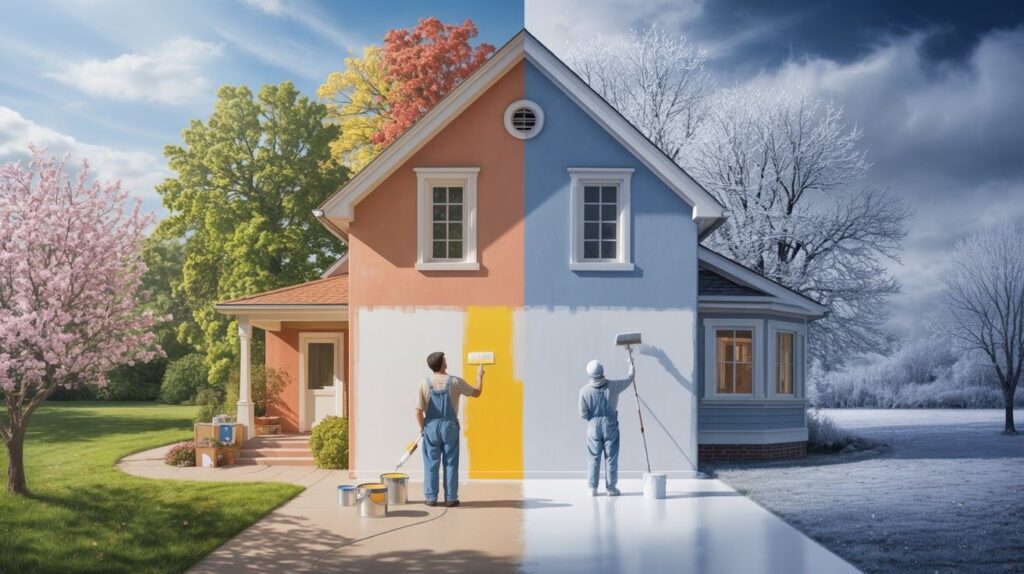
Why Spring and Fall Are Ideal
After years of painting in every season imaginable, I can tell you that spring and fall are absolute goldmines for exterior work. The weather stays consistent for days at a time-no surprise thunderstorms or sudden temperature swings that can ruin your progress.
These seasons offer that perfect sweet spot of mild temperatures and comfortable humidity levels.
Plus, you won’t be battling swarms of bugs that stick to wet paint or dealing with heavy pollen that turns your beautiful finish into a textured mess. I always book my biggest exterior projects during these windows.
Why Summer and Winter Can Be Tricky
Summer seems like the obvious choice, but it’s actually full of challenges. That intense heat makes paint dry so fast you can barely keep up, and direct UV rays can cause serious problems with adhesion and color consistency.
I’ve had to start jobs at 6 AM just to finish before the afternoon heat becomes unbearable.
Winter brings its own headaches, freezing temperatures stop most paints from curing properly, and frost creates moisture issues that can last for hours after sunrise.
With shorter daylight hours, you’re racing against the clock every single day. Some projects that take a weekend in spring can stretch into weeks during winter months.
Daily Timing Matters Too
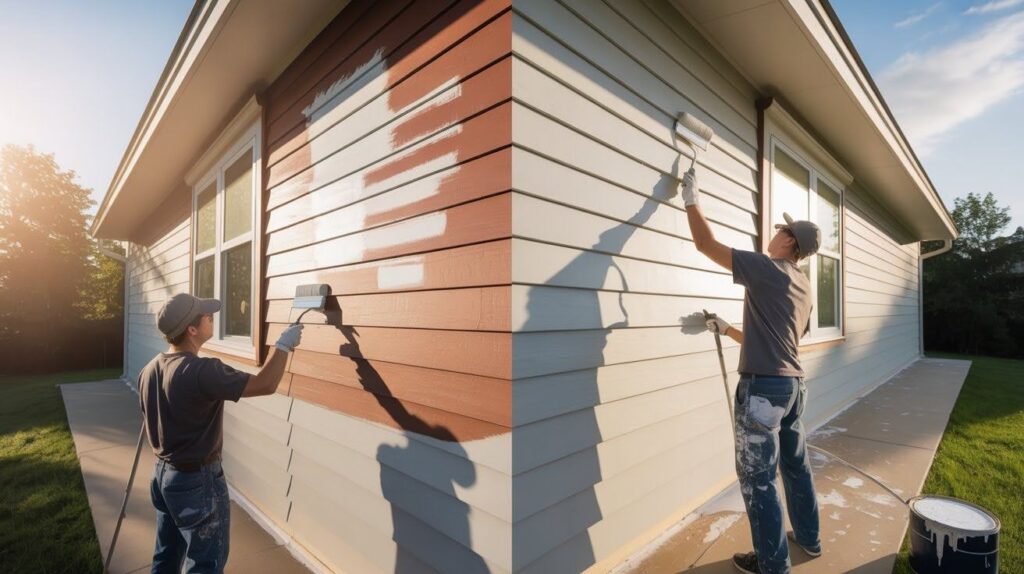
Avoid Direct Sunlight
Here’s something I learned the hard way early in my career: never chase the sun with your paintbrush. Direct sunlight heats up surfaces to scorching temperatures, making paint flash-dry before you can smooth it out properly.
I’ve seen lap marks appear within minutes on sun-baked siding.
The smart approach? Follow the shade around your house. Start on the east side in the afternoon when it’s cooled down, then move to the west side in the morning.
This way, you’re always working on surfaces that aren’t blazing hot, giving your paint time to level out and cure properly.
Don’t Paint Too Early or Too Late
I used to be that eager painter who started at dawn, only to watch my fresh paint job bubble and streak because of morning dew. Moisture on surfaces, even invisible moisture – creates adhesion problems that show up weeks later.
Similarly, painting too late in the day means your paint won’t have enough time to set before evening temperatures drop and humidity rises.
The sweet spot is typically between 10 AM and 4 PM, when surfaces are dry and warm but not blazing hot. This gives your paint the best chance to cure properly before conditions change.
Surface Preparation & Product Choice
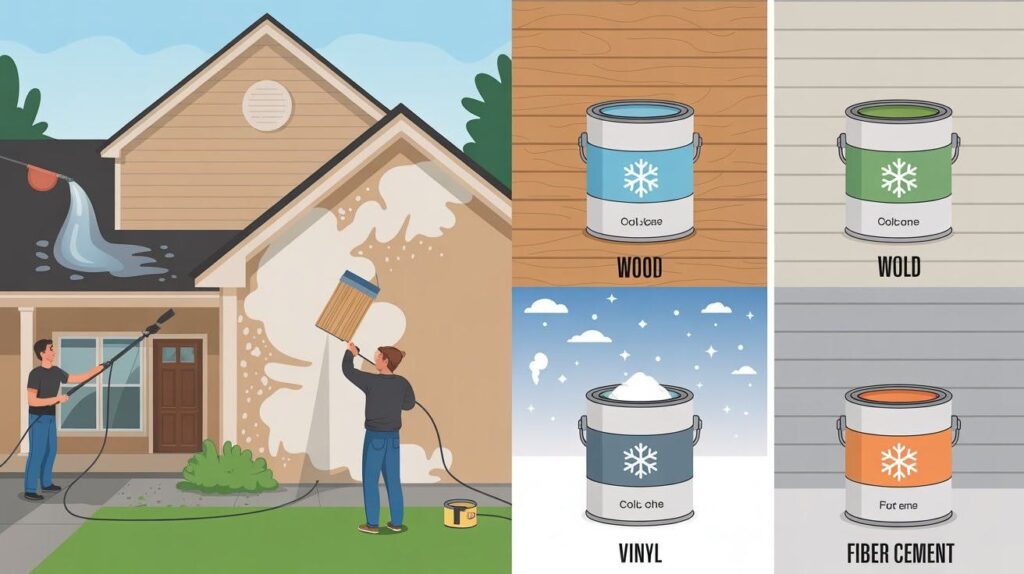
Always Paint on a Clean, Dry Surface
Proper prep work makes or breaks your paint job. Pressure wash your exterior walls and let them dry completely for 24-48 hours. Then scrape loose paint, sand rough spots, and fill holes.
Dirt, mold, and moisture create an invisible barrier that prevents proper adhesion. I’ve seen beautiful paint jobs fail within a year because someone skipped the cleaning step-even thin layers of pollen will cause premature peeling.
Choose the Right Exterior Paint
Cold-weather formulas like Sherwin-Williams Duration or Benjamin Moore Aura handle temperatures as low as 35°F, giving you more timing flexibility.
Match your paint to both climate and surface material, wood needs different formulas than vinyl or fiber cement. Read the technical data sheets to know exactly what conditions your paint can handle.
When to Call in the Pros
- Complex or large projects: Whole-house painting and intricate architectural details require experience beyond typical DIY skills.
- Multi-story homes and detailed trim: Safety risks aren’t worth taking, and pros have the right equipment, insurance, and expertise for working at heights.
- Professional timing and assessment: Experienced painters understand weather patterns, know when to push through borderline conditions, and can make prep and product choices that extend your paint job from years to decades.
Conclusion
After decades of exterior painting projects, I’ve learned that patience pays off more than rushing ever will. Remember the key warning signs: rain and moisture, windy conditions, extreme temperatures outside the 60°F-85°F range, and humidity above 70%.
These aren’t just guidelines, they’re the difference between a paint job that lasts two years and one that lasts twenty.
Planning ahead is your best strategy. Check extended weather forecasts, prep your surfaces properly, and choose the right paint for your climate and materials. If you’re facing a complex project or tight timeline, don’t hesitate to call in professionals.
They bring expertise in timing, weather assessment, and product selection that can save you thousands in the long run. Your home deserves better than a rushed weekend paint job.
Frequently Asked Questions
What temperature is too cold for exterior painting?
Most paints shouldn’t be applied below 50°F as they won’t cure properly, leading to poor adhesion and eventual failure. Some specialty cold-weather formulas can work down to 35°F, but always check your paint’s technical specifications.
Can I paint if it’s supposed to rain tomorrow?
No, you need at least 24 hours of dry weather after painting for proper curing. Even light rain or heavy dew within this window can ruin your finish and cause adhesion problems.
Is it okay to paint on a windy day?
Avoid painting when winds exceed 10-15 mph as debris will blow onto wet surfaces and cause uneven drying. Wind also creates safety hazards when using ladders and can make brush control nearly impossible.
What humidity level is too high for painting?
Humidity above 70% prevents proper paint drying and can cause bubbling, rough texture, and mildew growth. Wait for drier conditions or use a dehumidifier in enclosed areas if possible.
Can I paint in direct sunlight?
Direct sunlight causes paint to dry too quickly, creating lap marks and poor adhesion. Paint in shaded areas or follow the shade around your house throughout the day for best results.

